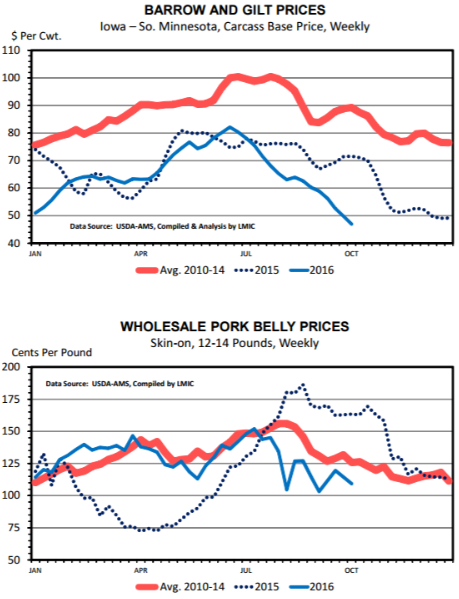



US Hog Prices Register Biggest Spring-Summer Decline in History
US - Hog prices in the just completed quarter registered the biggest spring to summer quarter decline in history (going back to 1980, at least), writes the Steiner Consulting Group.In percentage terms, the decline was 12.9 per cent based on Iowa‐Minnesota hog carcass prices. In 1998, the spring‐ to‐summer hog price decline, based on this price measure, was 15.2 per cent. The hog price for this summer was $63.68 per hundredweight, compared to $45.57 in the summer of 1998.
Pork production this summer was close to 6.1 billion pounds, up 140 million pounds from the spring quarter. During the summer of 2015, pork production was slightly less than 6.0 billion pounds, an increase of only 30 million pounds from the spring. Hog prices during the summer of 2015 went up (!) from the prior quarter (by less than 1 per cent). Pork production in the summer of 1998 increased close to 200 million pounds from the spring. Per capita consumption, on a retail weight basis, this summer was 12.2 pounds, versus 12.1 pounds last summer and 12.8 pounds in the summer of 1998.
The value of some components of the hog carcass did not mirror hog price trends this summer. The value of the loin portion of the carcass averaged 84 cents a pound this summer, down 3 cents from the spring. In the summer of 2015, the loin value declined 6 cents from the spring. Given the normal
proximity of pork loins (chops, etc.) in the grocery store meat case relative to beef steaks and ground beef, and the weakness in these beef prices, pork loins held value fairly impressively.
Likewise, wholesale ham prices moved up 6 cents a pound this summer, compared to a 5 cent increase a year earlier. The primary culprit out of the array of pork products that support the overall value of the hog carcass appears to be pork bellies, or bacon products. The value of the pork belly declined 11 cents per pound this summer, versus increasing 71 cents last summer. The catalyst for this year’s price performance appears to be pork belly inventories in cold storage at the beginning of the summer. On July 1, frozen belly inventories were 63 million pounds, a 50 per cent increase from July 1, 2015 inventories.
Similarly, on July 1,2014, belly inventories were 84 million pounds and the value of pork bellies declined 30 cents per pound from the spring to the summer. In the summer of 2014, pork production declined 80 million pounds from the spring, instead of increasing as it has in 2015 and 2016, which mitigated the impact that declining belly values had on hog prices that summer.
Last year, pork belly values declined 30 cents from the summer to the fall, due largely to the high values of the summer and the normal seasonal decline in consumer demand for bacon.
This year, belly prices start at a rather low value and additional declines may be small compared to a year ago. Hog prices during the last quarter of 2015 declined $16 per hundredweight, due in part to losses in belly product values. This year, if the summer‐to‐ fall hog price decline turns out be less than a year ago, it will likely be because of a relatively steady belly value.









